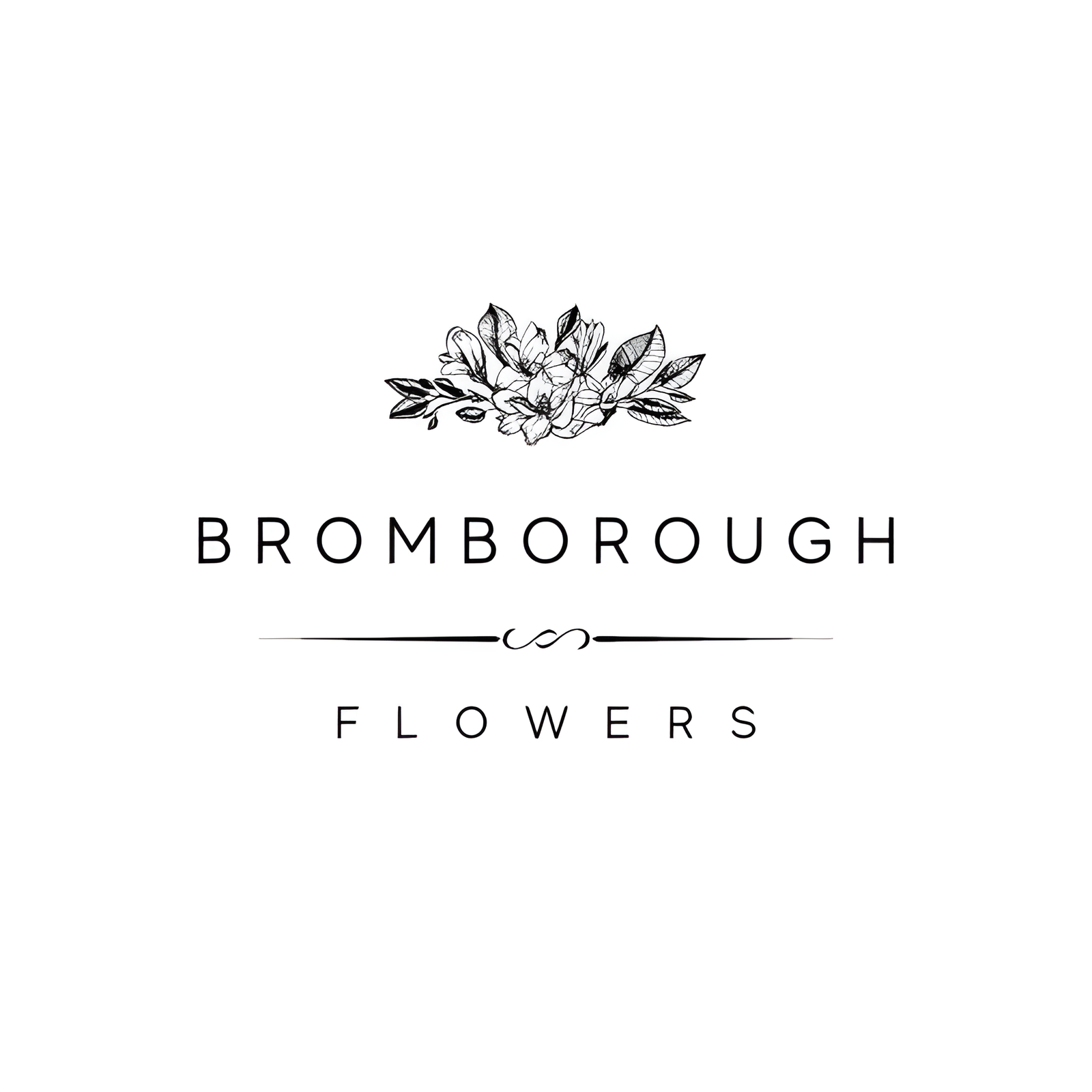When planning a wedding, selecting the right flowers is pivotal in creating an enchanting ambiance, and yarrow stands out as an exceptional choice. Known for its delicate clusters and finely divided foliage, yarrow adds a unique texture and depth to any floral arrangement. Available year-round in various vibrant colors, this versatile flower enhances bouquets and centerpieces with its enduring elegance and symbolism. Beyond its aesthetic appeal, yarrow's robust stems and impressive vase life make it a practical option for couples seeking both beauty and longevity in their wedding decor. But what deeper meanings and historical significance does yarrow carry?
Flower Overview
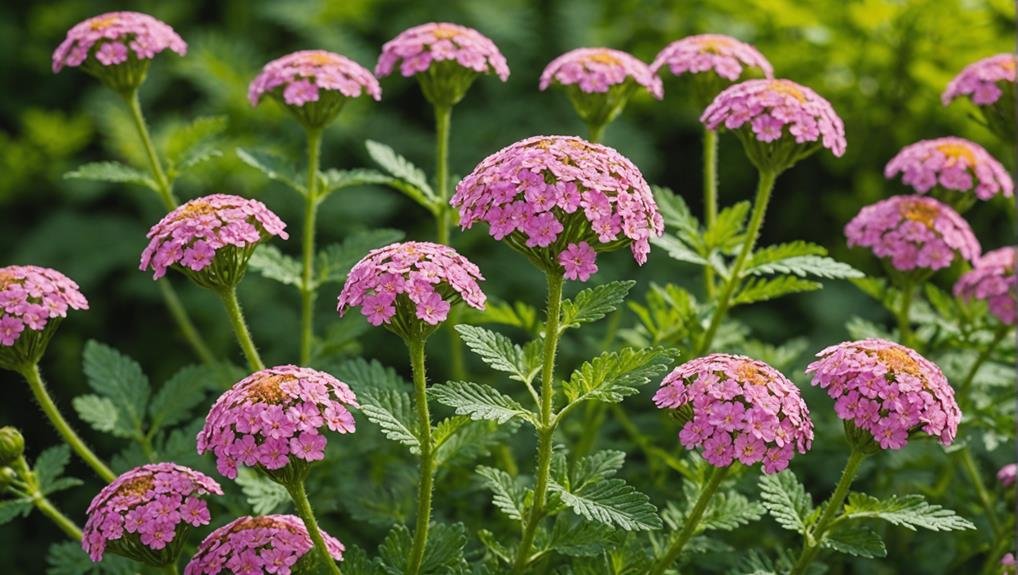
Yarrow flowers, from the Asteraceae family, are recognizable for their feathery leaves and vibrant colors. These versatile flowers are a popular option for wedding decorations because of their visual attractiveness and functional advantages.
Yarrow flowers act as excellent fillers, adding both color and texture to bridal bouquets, centerpieces, and other floral creations. Their multi-bloom clusters, which are approximately 24-26 inches long and 3-4 inches wide, provide a significant presence without overpowering other elements in the design.
Readily available year-round, yarrow flowers offer consistent accessibility, making them a dependable choice for weddings planned in any season. Their vase life of 7-10 days guarantees that arrangements stay fresh and visually pleasing throughout the wedding celebrations.
The historical importance and medicinal properties of yarrow also bring a sense of depth and heritage to modern wedding designs, connecting contemporary events with ancient customs. Whether featured in rustic, bohemian, or formal settings, yarrow flowers bring a natural charm and lasting beauty to any wedding floral arrangement. Their lasting allure and practical advantages make them a preferred option for florists and brides alike.
Physical Description
Characterized by their finely divided, feathery foliage and clusters of small, vibrant flowers, these botanicals make a striking addition to any wedding arrangement. Yarrow, a member of the Asteraceae family, is known for its distinctive fern-like foliage that adds texture and depth to floral designs. The leaves are intricately divided, giving them a delicate, feathery appearance that complements the flower clusters above.
Among the various types of yarrow, yellow yarrow stands out with its bright, cheerful hue, making it a popular choice for adding a pop of color to wedding bouquets and centerpieces. The flowers themselves are composed of numerous tiny blossoms that form a flat-topped cluster, creating a visually appealing contrast to the soft, airy foliage below.
Commonly found in meadows and fields, yarrow was introduced to North America by early colonists and has since become a versatile element in floral arrangements. Its robust stems and long-lasting blooms make it an ideal filler, capable of enhancing the overall structure and aesthetic of wedding floral designs.
Whether used in rustic, garden-inspired settings or more formal arrangements, yarrow's unique physical characteristics ensure it remains a favored choice among florists and brides alike.
Available Colour Varieties
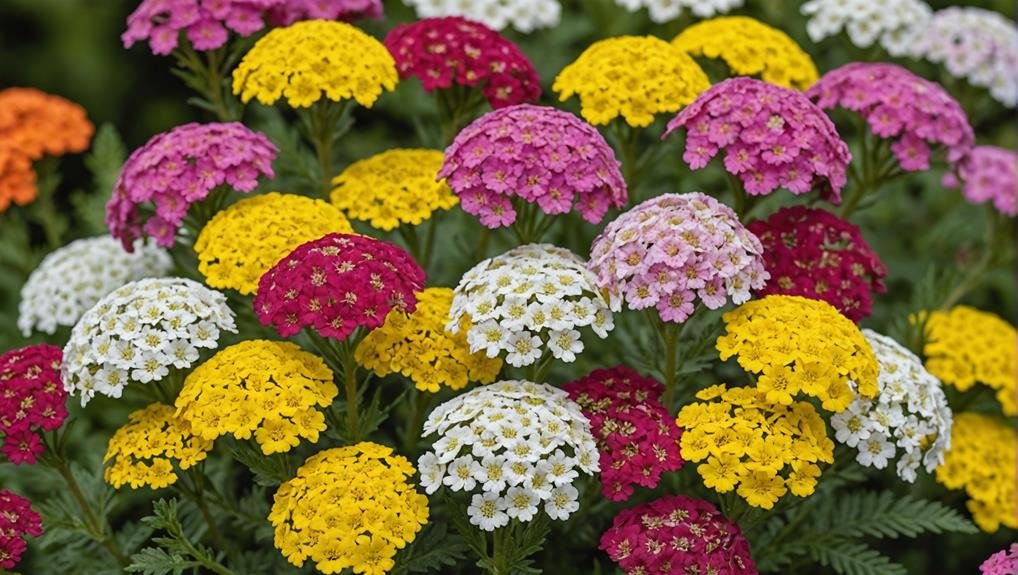
Offering a range of hues, yarrow flowers are available in classic white and vibrant yellow, with occasional shades of pink, red, or pastels to suit various wedding color themes. The white variety of yarrow is particularly popular for its ability to complement any color scheme, making it a flexible choice for a wide range of floral arrangements.
Yellow yarrow, on the other hand, infuses an element of joy and optimism, perfect for weddings that aim to evoke a sunny and cheerful atmosphere.
The choice of yarrow color can greatly impact the overall aesthetic of the wedding. Here are key points to take into account:
- Versatility: White yarrow can blend seamlessly with nearly any wedding color palette, offering a neutral yet elegant touch.
- Vibrancy: Yellow yarrow adds a lively and bright element to floral arrangements, ideal for daytime or outdoor ceremonies.
- Depth and Richness: Pink, red, and pastel varieties introduce depth and richness, enhancing the visual appeal of bouquets and centerpieces.
- Harmonious Blending: Yarrow's diverse colors harmonize well with other flowers such as roses, Queen Anne's lace, and globe thistle, creating balanced and cohesive floral designs.
The diverse color options of yarrow ensure it remains a versatile choice for weddings, enabling couples to find the perfect hue to match their style and preferences.
Latin Name and Taxonomy
Known scientifically as Achillea millefolium, this versatile perennial belongs to the Asteraceae family. The taxonomic classification of yarrow reflects its deep-rooted ties to ancient history and mythology, particularly its association with the Greek hero Achilles, who is said to have used the plant for its healing properties.
Achillea is available in a variety of cultivars, each distinguished by its unique flower colors and foliage texture. The Asteraceae family, often referred to as the daisy or composite family, is one of the largest families of flowering plants. Yarrow's placement within this family underscores its botanical significance and diverse applications.
Characterized by its feathery foliage and flat-topped flower clusters, Achillea millefolium exhibits a structured yet delicate appearance that makes it a popular choice for wedding bouquets and floral arrangements. In terms of taxonomy, the genus Achillea encompasses numerous species and hybrids, with Achillea millefolium being one of the most well-known.
This classification not only highlights the plant's robust adaptability but also its ornamental and medicinal value across various cultures. As a member of the Asteraceae family, yarrow continues to be celebrated for its aesthetic appeal and multifaceted uses.
Geographical Origins
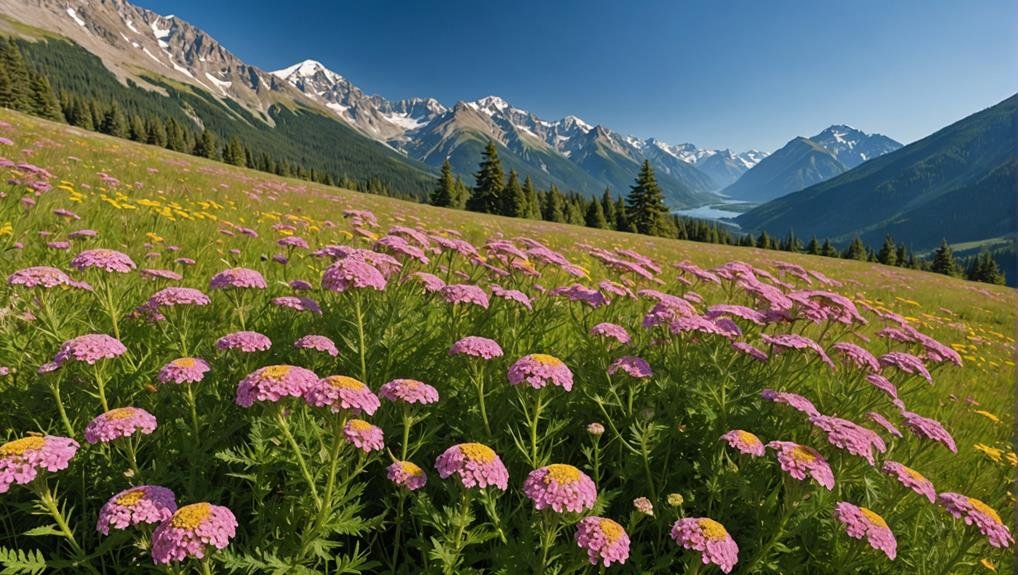
Yarrow originates from the northern hemisphere, flourishing naturally across Europe and temperate regions of Asia. This perennial herb, belonging to the Asteraceae family, showcases a remarkable adaptability to various climates and terrains. Its geographical origins are deeply rooted in areas with moderate to cool temperatures, where it thrives in meadows, grasslands, and open forests.
The widespread presence of yarrow in these regions can be attributed to several factors:
- Climate Adaptability: Yarrow is highly resilient to a range of climatic conditions, making it a common sight in both Europe and Asia.
- Soil Versatility: This plant grows well in different soil types, from sandy to clayey, provided there is good drainage.
- Historical Cultivation: The historical significance of yarrow in traditional medicine and mythology has led to its cultivation and naturalization in various parts of the world.
- Ecological Role: Yarrow's ability to attract pollinators and its use as a companion plant in agriculture have contributed to its widespread distribution.
These geographical origins not only highlight yarrow's resilience and adaptability but also emphasize its enduring appeal in floral arrangements. Understanding its natural habitat provides valuable insights into its growth patterns and cultural significance, enriching its role in wedding floristry.
Season Availability
The year-round presence of yarrow flowers guarantees their continuous availability for weddings and events, making them an exceptionally versatile choice. This perennial availability guarantees that yarrow can be seamlessly integrated into floral arrangements regardless of the season.
Brides and event planners can rely on the ongoing presence of yarrow, allowing for greater flexibility in design and theme. Yarrow's extended availability throughout the year eliminates concerns related to seasonal limitations. Unlike some flowers that are only accessible during specific months, yarrow offers a lasting option that can complement various wedding styles, from rustic to elegant.
This means that whether a wedding is planned for the vibrant colors of spring, the warm hues of summer, the rich tones of autumn, or the cool shades of winter, yarrow can be a constant presence. Additionally, the continuous availability of yarrow guarantees that it can be incorporated into wedding flower arrangements at any time, without the risk of last-minute substitutions or compromises in floral design.
This reliability is particularly beneficial for weddings, where the timing and availability of floral elements play an essential role in the overall aesthetic. Overall, yarrow's year-round availability provides unparalleled convenience and versatility for wedding floral arrangements.
Growing Conditions
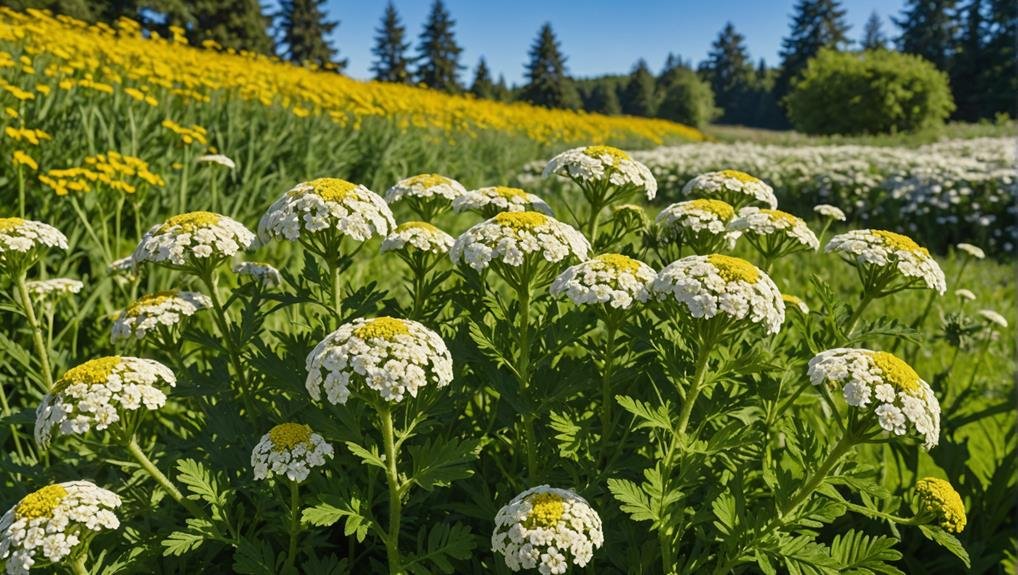
To achieve ideal growth, yarrow needs full sunlight exposure, well-draining soil, and moderate moisture levels. Securing these conditions will help yarrow plants thrive and become perfect additions to DIY flower arrangements and various floral designs.
Yarrow's cultivation demands specific attention to several vital factors:
- Sun Exposure: Plant yarrow in a location that receives at least six hours of direct sunlight daily. Inadequate light can lead to leggy growth and fewer blooms.
- Soil Drainage: Well-draining soil is necessary to prevent waterlogging, which can cause root rot and other diseases. Enhancing soil with sand or gravel can improve drainage.
- Moisture Levels: While yarrow is relatively drought-tolerant, maintaining moderate moisture levels, especially during establishment, promotes healthy growth. Avoid overwatering, as saturated soil can be harmful.
- Spacing: Proper spacing between yarrow plants is essential to ensure good air circulation and reduce the risk of winter rot. Space plants about 12 to 24 inches apart.
Yarrow typically requires at least one year to bloom from seed, making it a long-term investment for any garden. Harvesting yarrow during cooler temperatures and choosing mature flower heads will yield the best results for your floral designs. With its dome shape, yarrow serves as an excellent filler flower, complementing a variety of arrangements.
Cultural Significance
In ancient traditions, yarrow has been revered for its medicinal properties and symbolic meanings, making it a flower steeped in cultural heritage. Named after the Greek hero Achilles, who used the plant to treat wounds, yarrow has been associated with themes of protection and healing for centuries. Historically, soldiers carried yarrow for its ability to stop bleeding and aid in recovery, embedding the flower in various cultural narratives of courage and resilience.
In Greek mythology, yarrow symbolizes courage, strength, and protection, qualities that have transcended time and geography to influence its modern-day significance. The flower's rich historical associations make it an evocative choice for wedding flowers, infusing bridal bouquets and arrangements with layers of meaning and tradition.
The delicate flower clusters of yarrow not only enhance the visual appeal of floral designs but also carry connotations of love and the enduring power of nature. Incorporating yarrow into wedding flower arrangements can symbolize resilience and the strength found within relationships, adding both aesthetic and emotional depth to the celebration.
Therefore, yarrow stands as a meaningful component in wedding flower selections, bridging ancient wisdom with contemporary festivity.
Typical Use in Weddings
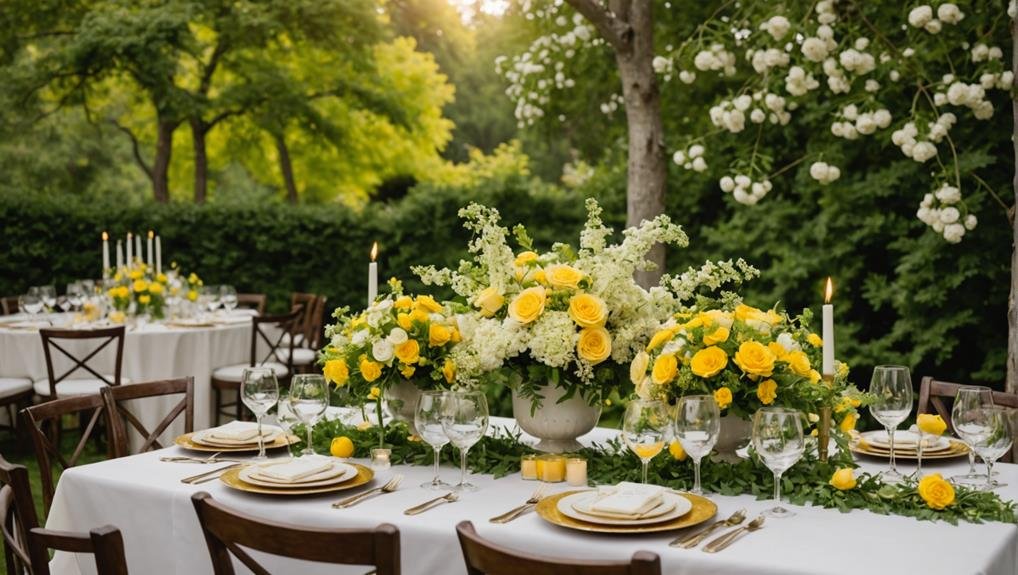
Yarrow's symbolic significance and versatile beauty make it a popular choice for various wedding arrangements. It enhances bouquets, centerpieces, and boutonnieres with its vibrant hues and textured foliage. Its availability in bright colors like yellow and white, and even bright red, allows for dynamic and engaging floral designs, appealing to a wide range of wedding themes and styles.
DIY wedding enthusiasts particularly appreciate yarrow for its hardiness and compatibility with a wildflower aesthetic. Its deep mustard and yellow tones provide a natural, rustic charm that pairs seamlessly with other floral elements such as roses, Queen Anne's Lace, and Globe Thistle. This makes yarrow an ideal choice for creating harmonious and eye-catching arrangements.
Here are some typical uses of yarrow in weddings:
- Bridal Bouquets: Yarrow adds texture and color, complementing more traditional flowers like roses.
- Centerpieces: Its vibrant hues and feathery foliage enhance table arrangements, providing a natural, meadow-like vibe.
- Boutonnieres: Yarrow's small clusters make for perfect, understated boutonnieres that hold up well throughout the day.
- Floral Arches: For outdoor ceremonies, yarrow can be woven into floral arches, contributing to a lush, garden-inspired look.
Alternative Flower Types
For couples looking to diversify their floral arrangements, several alternative flower types can complement or replace yarrow while maintaining a cohesive aesthetic. One popular choice is Queen Anne's Lace, known for its delicate, lacy appearance that adds a touch of elegance and lightness to any bouquet. This flower pairs well with yarrow's feathery foliage, creating a balanced and visually appealing arrangement.
Another excellent alternative is the Globe Thistle. Its spherical blue blooms provide a striking contrast to yarrow's flat-topped flowers, adding depth and texture to your arrangements. Globe Thistle's hardy nature makes it a sustainable option, similar to yarrow, which can be attractive for eco-conscious couples.
For a more traditional touch, roses are an exceptional choice. Available in a myriad of colors, they can seamlessly integrate with yarrow's versatile hues, from deep reds to soft pinks. Roses also bring a classic, romantic flair to any wedding decor.
DIY brides may appreciate the ease of incorporating these flowers into their arrangements. Their varied textures and complementary colors make them ideal for creating beautiful, personalized floral displays that capture the essence of the special day. Whether aiming for a wildflower vibe or a more polished look, these alternatives offer flexibility and beauty.
